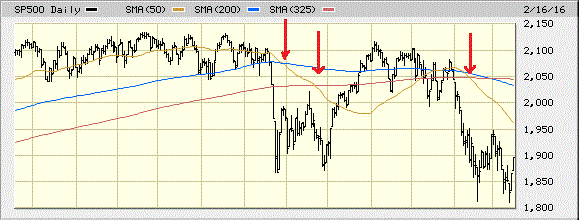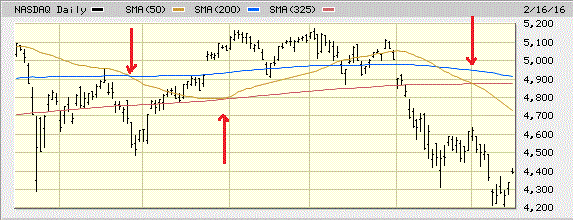Using The Double-Death Cross To Confirm A Bear Market In U.S. Stocks
As discussed in, the Double-Death Cross is when the 50-day (10-week) moving average falls below the 325-day (65-week) after falling below the 200-day (40-week). The 50-day (10-week) falling below the 325-day (65-week) is used to confirm that the 50-day (10-week) moving average crossing the 200-day (40-week) was a valid sell signal. The Double-Death Cross has many uses and can be used to verify a bear market in stocks, but it requires using more than one market index to do so.
In the United States, the charts of the Dow Jones Industrial Average, the S&P 500, the Nasdaq, and the Russell 2000 need to be used. These indices represent an array of stocks with big caps and small caps and tech stocks and non-tech stocks. It is possible that other combinations would work too (such as a big cap, mid cap, small cap index), but it was the Nasdaq that proved to be the pivotal index in determining whether or not the U.S. stock market would remain bullish or turn bearish in the fall of 2015 and in early 2016.
Stocks took a nosedive globally in August 2015 with prices plunging below the 50-day, then the 200-day and then the 325-day moving averages. In the U.S. the 50-day moving average fell below the 200-day in August for the Dow and the S&P 500, at the beginning of September for the Russell 2000 and then in late September for the Nasdaq. This was followed by the 50-day falling below the 325-day in early September for the Dow and then in mid-September for the S&P 500 and the Russell 2000. In all three cases, the 200-day moving average had peaked and was heading down when the 50-day crossed the 325-day, adding further verification that that each index had taken a bearish turn. This sell signal would prove to be premature for two of the indices, however.


The Nasdaq failed to make the 50-day/325-day confirmation cross and moreover its 200-day moving average continued to rise, indicating the bull market wasn’t quite ready to give up the ghost just yet. In late October 2015, the Nasdaq’s 50-day “bounced” off the 325-day instead of penetrating it and started heading back up after the Nasdaq, along with the Dow and the S&P 500, made a double bottom on the charts in late September. Their prices then rose above the 325-day, the 50-day, and the 200-day. The 50-day moving average for all three followed and was back above the 200-day in December, although not by much.
The Russell 2000 was the exception. It went on to develop a bear market pattern with its price mostly staying at or below its 325-day moving average so the 50-day couldn’t rise above it.

The bearish behavior of the Russell 2000 was an indication the other averages would soon join it. Just as the Nasdaq held the market up, the Russell helped lead the market down. The Dow and S&P 500’s 50-day fell below both the 200-day and 325-day in mid-January 2016. The Nasdaq’s 200-day moving average started moving down early in the month and its 50-day fell below it just after the Dow and S&P 500 made their own crosses. By the beginning of February, the Nasdaq’s 50-day was below the 325-day and a bear market was confirmed.

It should be kept in mind that a fully-formed bear market actually requires a little more technically speaking and the Double-Death Cross on the Dow, the S&P500, the Nasdaq and Russell 2000 is indication that this will occur. The additional details are the topic for another article.
All references above are to simple moving averages.
None.



